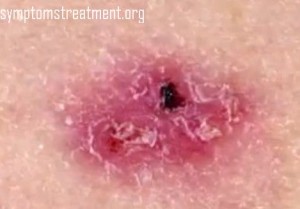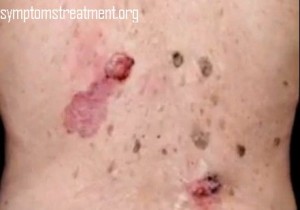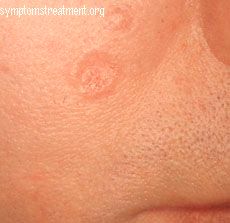Skin cancer has become one of the most common types of cancers in the United States nowadays. The most evident indicator of skin cancer is the noticeable change in skin color and the presence of some sores that do not heal for a long period of time. Skin cancer occurs when abnormal cells invade the outer parts or layers of the skin. There are three major types of skin cancer – basal cell cancer, squamous cell cancer and melanoma. The most serious of the three is melanoma. Both the basal cell and squamous cell cancers are collectively termed as non melanoma cancer.
It is important to be aware of skin cancer. Exposure to sunlight is one of the causes and most people are exposed to sunlight every day. One should be conscious of the causes of skin cancer in order to avoid developing it. If by an unfortunate event, an individual acquires this disease, it is important also to know the symptoms in order to address the skin cancer immediately.
Types of Skin Cancer and their Symptoms
As aforementioned, there are three types of skin cancer. Each type will now be scrutinized one by one:
• Basal cell cancer
Basal cell cancer is the most common type of skin cancer. A basal cell carcinoma looks like a bump or a large pimple that is soft and shiny and somewhat translucent. These bumps are often found on the back or the chest. It would start small but would grow bigger in months. However, this type of skin cancer does not metastasize, which means the cancer cells do not migrate to other parts of the body. The risk factors that account to why an individual could get this type of skin cancer include exposure to sun and ultraviolet radiation and aging.
• Squamous cell cancer
Squamous cell cancer physically looks like dry rough bumps on the skin and would resemble the scales of fish when viewed under the microscope. These bumps are often found at the back of the hands, scalp, ears and face. These bumps look rough but would feel tender under the touch. The factors that contribute to developing squamous cell cancer include exposure to sunlight, x-ray and chemicals such as arsenic and hydrocarbon. This type of skin cancer can metastasize to other parts of the body if it is not treated right away.
• Melanoma
Melanoma is the most serious type of skin cancer since the cancer cells can metastasize quickly to other parts of the body. An indicator of a melanoma is a spot or a mole that is bigger than a pencil eraser. That spot would look irregular with characteristic rough edges. If it looks like a mole, both sides of the mole are not symmetrical. Caucasians are at high risk for melanoma, while extreme exposure to sunlight could also result to melanoma.
Treatment for Skin Cancer
There is a wide array of treatment options for skin cancer. However, the doctor would also have to consider several things before deciding on the best course of treatment. These factors include the type of skin cancer the individual has; the location or region where the spot or rash is seen; whether it is operable or not; the risk of scarring; the overall health of the patient, if he/she is healthy enough to undergo surgery; and the person’s age.
Here are the common treatment options used to treat skin cancer:
• Curettage and desiccation are the most preferable treatment alternative for both the doctor and the patient. The doctor would use a curette to dig the affected skin out while applying electric current on the skin to prevent it from bleeding severely and to kill the surrounding cancer cells. This would not need any stitching up because the skin will eventually heal on its own. This is the best option for those who have detected skin cancer at an early phase.
• Another approach is surgery. This is done to excise the tumor out of the skin. Since this would cause a bigger incision on the skin, stitching would be done to close up the slit area.
• One can also opt for radiotherapy. Radiotherapy exposes the patient to gamma rays in order to kill the cancer cells. This is a less painful procedure but would give the patient unfavorable side effects such as hair loss, nausea and vomiting. A successful treatment using radiotherapy may be achieved after 20 to 30 sessions.
• Cryosurgery is also an option wherein the abnormal cells are frozen and killed with the use of the liquid nitrogen injected inside the body.
Useful Tips on how to Prevent Skin Cancer
• Since the primary cause of skin cancer is exposure to sunlight, an individual should not stay out too long under the heat of the sun.
• If it’s very hot outside and one needs to go somewhere, an umbrella must be used to avoid direct contact of the sunlight to one’s skin. A wide brimmed hat as well as long sleeved shirt is also advisable to don.
• An individual must wear sun block or sun screen that has SPF 30 or higher especially during seasons when the sun is nearer the earth. This would greatly help protect one’s skin from receiving harmful ultraviolet rays from the sun.
• Avoid tanning salons. The light used there to create the artificial sun-kissed skin tone is made up of harmful rays that could cause skin cancer.
• If an individual observes a lesion, a spot, or a suspicious rash, he/she must immediately have it checked by a doctor. One should keep in mind that early detection would make the treatment more effective, faster and less complicated.
Skin cancer has become rampant these days. It should be always kept in mind that taking care of the skin and avoiding too much sun exposure is the best way to avoid having this unwanted disease. Prevention is indeed better than cure; an individual must take care of his or her skin because skin cancer is a tough battle to fight.
Pictures of skin cancer
Check out skin cancer photos to find how they look under diagnosis




